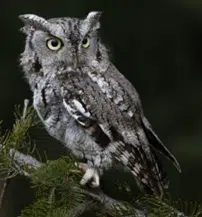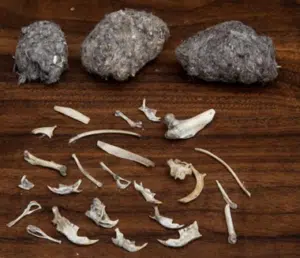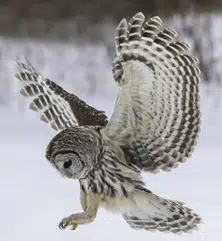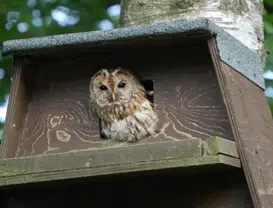
Figure 1. Eastern Screech Owl
We are lucky in Loudoun County to have such a wide variety of different owls. To list a few, we have the Eastern Screech owl, Barred owl, Barn owl, Great Horned owl, Short-Eared owl, and Northern Saw-Whet owl.
How big do they usually get?
In some species, the males and females are relatively the same size, in other species like the Short-Eared owl the male is smaller than the female. The smallest owl we have year-round in Loudoun County is the Eastern Screech owl, measuring in at 8.5 inches in length and up to 20 inches in wingspan. The Great Horned Owl is the largest, having a length of 23 inches and a wingspan of up to 57 inches.

Figure 2. Example of owl pellets
What do they eat?
The main part of their diet includes small birds and rodents, ants, frogs, snakes, moths and spiders. Owls are unable to chew their food, so they eat it whole and are able to regurgitate the hair, bones, and other undesirable parts into what are called pellets.
What makes owls so unique?
Owls have two sets of wings, primary and secondary. The sets of wings differ in structure but both help to minimize turbulence and absorb sound. This adaptation makes the owl almost silent in flight, which aids in hunting.
Another interesting fact about the physiology of owl wings is that the structure varies based on where a certain species hunts most frequently. Owls that hunt primarily over fields or marshes, like the Short-Eared owl, typically have more narrow wings that stretch loger, while owls that hunt mainly in the woods, like Barred owls, will have short, broad wings.
Owls have evolved to have extremely large eyes in order for them to see better at night while hunting. The eye structure is different from our eyes and because of the size they are unable to move their eyes back and forth like we can, so they have to move their entire head! They are able to turn their heads up to 270 degrees!
Not only do they have excellent vision, but they have incredible hearing as well. Even though you can’t always see an owl’s ears doesn’t mean they aren’t there. Owls’ ears are located on the sides of their head and are asymmetrical, meaning one ear is higher than the other. Their asymmetrical ears allow the owls to be more accurate determining exactly where their prey are located. Precise hearing is extremely important for an owl to survive—itt allows them to hunt prey at night as well as navigate safely through a territory.
 How do owls hunt their prey?
How do owls hunt their prey?
Owls have razor sharp talons on their feet, these are used to grab their prey as they fly over. Because owls have such large wings, they are able to carry lots of weight. Some species can carry up to three times their own body weight!
How to tell if there are owls in your area:
Look for owl pellets, typically found under thick branches where owls like to perch.
When you’re sitting outside at night, listen for owl calls. You won’t be able to hear them fly, but you’ll be able to hear them call!
If you ever find yourself on a night walk or hike, look to the trees and see if you can spot one! You might have even more luck if you’re able to make a convincing owl call!
How can you help owl conservation efforts?
- Consider installing an owl box on your property. Barn owls and Screech owls are known to use nesting boxes and can help keep the rodent population down in an area. Reach out to the Conservancy to see if you have a suitable habitat for an owl box on your property!
- Another option is to install a chimney cap on your chimney. Smaller owls and other critters have been known to get into chimneys and get stuck. To prevent this you can install a chimney cap.
- You can also leave bare branches or dead trees (should they not pose a hazard) on your property instead of removing them. These are locations that owls are known to roost or perch when hunting.
- An important step you can take to help is to decrease your light pollution. Since most owls are nocturnal, they will avoid well lit areas at night. Turning off your outdoor lights at night may attract more owls to hunt near your home.
Next time you see or hear an owl, try to identify it! Share your owl pictures or videos with us at info@willowsfordconservancy.org.
Check out this page to help you identify owl calls: Know Your Nocturnal Neighbors: Nine Owl Sounds to Listen For | ABC (abcbirds.org)
But please always remember to admire from a distance, for your safety and the safety of our wildlife!
